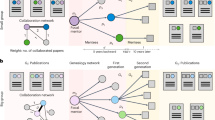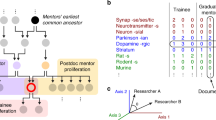Abstract
The mentor plays an important role in initiating a process of cumulative advantage for the student. Our analyses present a clear and systematic pattern of effects of the mentor on the careers of biochemists. The influence of the mentor begins with collaboration, which is the single most important factor affecting the student's predoctoral productivity. For those who collaborate, the effects of both eminence and performance further increase the student's predoctoral productivity. The mentor's performance has weak effects on the productivity of noncollaborating students. For those who collaborate with their mentor, the mentor continues to influence the career with a positive effect of the mentor's performance on academic placement, an effect not found for noncollaborators. Even though the mentor's performance affects the student's placement, the student's performances doesnot affect that placement, suggesting a process of ascription. For those who collaborate with their mentor, the mentor's performance increases the student's later publications and citations. For noncollaborators, whose mentors are much less productive during the student's period of doctoral study, the mentor's eminence has a smaller, but significant effect on later productivity. Overall, the advantages of a strong mentor are drawn upon and enhanced through processes of both achievement and ascription.
Similar content being viewed by others
References
H. ZUCKERMAN, Stratification in American Science, Pp. 235–257, in: E. O. LAUMANN (Ed.),Social Stratification, Bobbs-Merrill, Indianapolis, 1970 p. 244.
M. POLANYI,The Tacit Dimension, Doubleday & Company, Garden City, NY, 1966.
D. E. CHUBIN,Social Trappings of Knowledge, Book manuscript under review, 1980.
M. OVERINGTON, The Scientific Community as Audience: Toward a Rhetorical Analysis of Science,Philosophy and Rhetoric, 10 (1977) 145.
D. G. BROWN,The Mobile Professors, American Council on Education, Washington, 1967.
J. R. COLE, S. COLE,Social Stratification in Science, University of Chicago Press, Chicago, 1973, p. 117.
T. CAPLOW, R. McGEE,The Academic Mareketplace, Doubleday, Garden City, NY, 1958.
L. L. HARGENS, W. O. HAGSTROM, Sponsored and Contest Mobility of American Academic Scientists,Sociology of Education, 40 (1967) 24–38.
R. H. TURNER, Sponsored and Contest Mobility and the School System,American Sociological Review, 25 (1960) 855–867.
H. ZUCKERMAN,Scientific Elite, The Free Press, New-York 1977, 207.
B. BERELSON,Graduate Education in the United States, McGraw-Hill, New York, 1960.
B. F. RESKIN, Academic Sponsorship and Scientists Careers,Sociology of Education, 52 (1979) 131.
H. ZUCKERMAN, R. K. MERTON, Patterns of Evaluation in Science: Institutionalization, Structure and Functions of the Referee System,Minerva, 9 (1971) 66–100.
H. ZUCKERMAN, R. K. MERTON, Age, Aging and Age Structure in Science, Pp. 292–356, in: M. W. RILEY et al. (Eds),Aging and Society: Volume III,A Theory of Age Stratification, Russel Sage Foundation, New York, 1972.
J. S. LONG, Productivity and Academic Position in the Scientific Career,American Sociological Review, 43 (1978) 889–908.
J. S. LONG, P. D. ALLISON, R. McGINNIS, Entrance into the Academic Career,American Sociological Review, 44 (1979) 816–830.
R. McGINNIS, P. D. ALLISON, J. S. LONG, Postdoctoral Training in Bioscience,Social Forces, 60 (1981) 701–722.
J. S. LONG, R. McGINNIS Organizational Context and Scientific Productivity,American Sociological Review, 46 (1981) 422–442.
19xx American Men (and Women) of Science, R. R. Bowker Co., Cattel Press New York.
A. M. CARTTER,An Assessment of Quality in Graduate Education, American Council on Education, Washington, 1966.
K. D. ROOSE, D. J. ANDERSEN,A Rating of Graduate Programs, American Council on Education, Washington, 1970.
A. W. ASTIN,Predicting Academic Performance in College, Free Press, New York, 1971.
19xx Science Citation Index, Institute for Scientific Information, Philadelphia.
J. S. LONG, R. McGINNIS, P. D. ALLISON, The Problem of Junior-authored Papers in constructing Citation Counts,Social Studies of Science, 10 (1980) 127–143.
L. L. HARGENS, G. M. FARR, An Examination of Recent Hypotheses about Institution Inbreeding,American Journal of Sociology, 78 (1973) 1381–1402.
J. S. LONG,A Simple Probability Model for Collaboration, Research Note, Washington State University, 1983.
R. J. WONNACOTT, T. H. WONNACOTT,Econometric Theory, Wiley, New York, 1979, 95–98.
W. O. HAGSTROM, Traditional and Modern Forms of Scientific Teamwork,Administrative Science Quarterly 9 (1964) 241–263.
W. O. HAGSTROM,The Scientific Community, Basic Books, New-York 1965.
W. O. HAGSTROM, Inputs, Aoutputs and the Prestige of University Science Departments,Sociology of Education, 44 (1971), 375–397.
Author information
Authors and Affiliations
Rights and permissions
About this article
Cite this article
Long, J.S., McGinnis, R. The effects of the mentor on the academic career. Scientometrics 7, 255–280 (1985). https://doi.org/10.1007/BF02017149
Received:
Issue Date:
DOI: https://doi.org/10.1007/BF02017149




